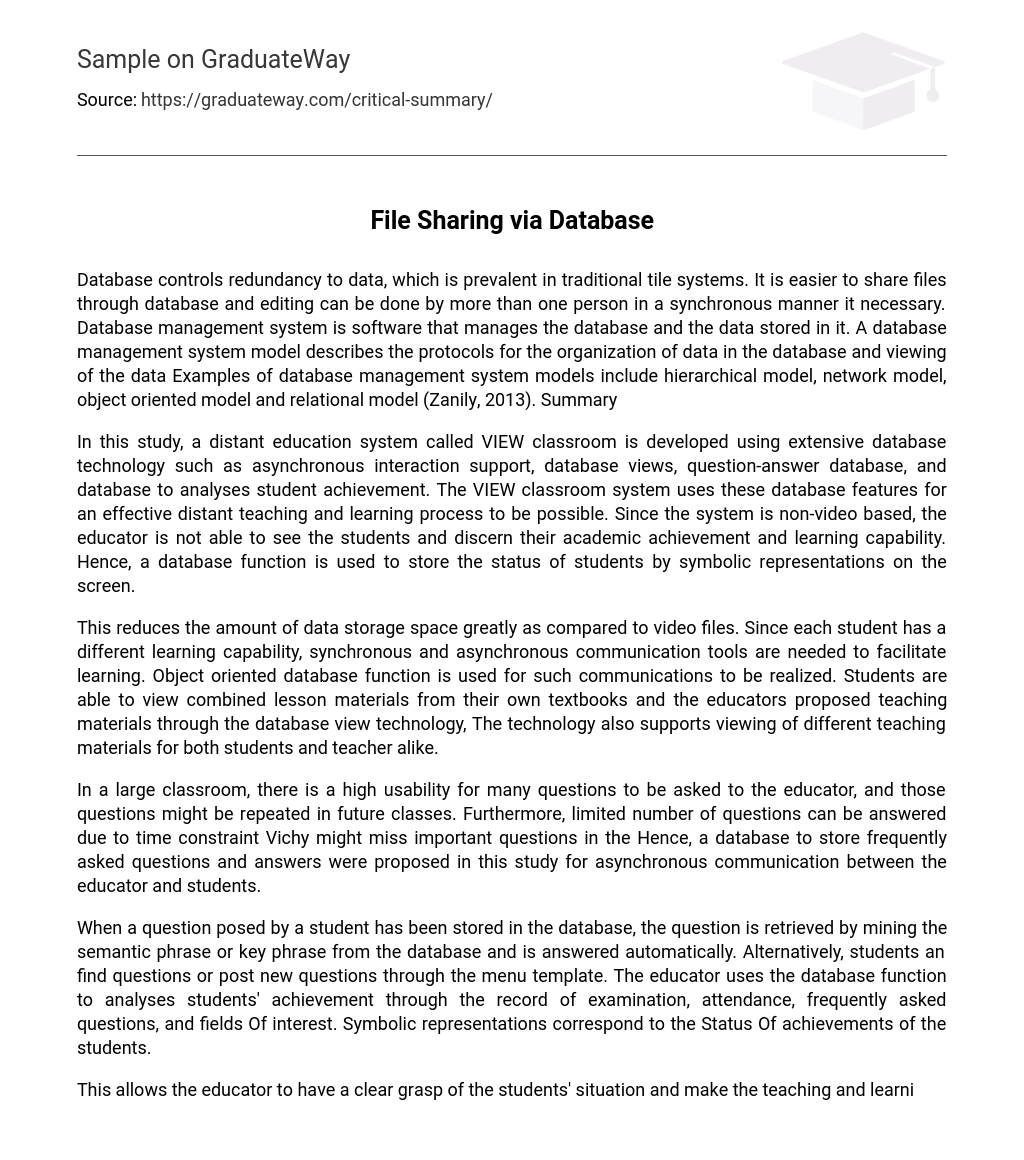Database controls redundancy to data, which is prevalent in traditional tile systems. It is easier to share files through database and editing can be done by more than one person in a synchronous manner it necessary. Database management system is software that manages the database and the data stored in it. A database management system model describes the protocols for the organization of data in the database and viewing of the data Examples of database management system models include hierarchical model, network model, object oriented model and relational model (Zanily, 2013). Summary
In this study, a distant education system called VIEW classroom is developed using extensive database technology such as asynchronous interaction support, database views, question-answer database, and database to analyses student achievement. The VIEW classroom system uses these database features for an effective distant teaching and learning process to be possible. Since the system is non-video based, the educator is not able to see the students and discern their academic achievement and learning capability. Hence, a database function is used to store the status of students by symbolic representations on the screen.
This reduces the amount of data storage space greatly as compared to video files. Since each student has a different learning capability, synchronous and asynchronous communication tools are needed to facilitate learning. Object oriented database function is used for such communications to be realized. Students are able to view combined lesson materials from their own textbooks and the educators proposed teaching materials through the database view technology, The technology also supports viewing of different teaching materials for both students and teacher alike.
In a large classroom, there is a high usability for many questions to be asked to the educator, and those questions might be repeated in future classes. Furthermore, limited number of questions can be answered due to time constraint Vichy might miss important questions in the Hence, a database to store frequently asked questions and answers were proposed in this study for asynchronous communication between the educator and students.
When a question posed by a student has been stored in the database, the question is retrieved by mining the semantic phrase or key phrase from the database and is answered automatically. Alternatively, students an find questions or post new questions through the menu template. The educator uses the database function to analyses students’ achievement through the record of examination, attendance, frequently asked questions, and fields Of interest. Symbolic representations correspond to the Status Of achievements of the students.
This allows the educator to have a clear grasp of the students’ situation and make the teaching and learning process to be understandable. The design of the database for the VIEW Classroom system takes into account for the data used in the system and the data sharing mechanism. The data used in the yester such as data prepared for lecture, generation of data during and after lecture, as well as the relationship among these data are stored in the database. These data can be shared using the view function of the database.
Authorization mechanism is designed for controlled access to copyrighted documents, examination questions and private records of students (Gawks &Kambayashi, 1997). Insights As the size of the classroom is relatively huge, data shared between educators and students are vast and data duplication will be a concern as this is a waste of space and is costly to maintain such redundancy in a long run, Besides that, tit the large amount of students, it is not easy to extract records of interest.
With the implementation of database technology in VIEW Classroom system which uses the object oriented database management system, data redundancy is minimalists and this improves the retrieval of records that are relevant_ Data stored in the VIEW Classroom consists of non-traditional data such as graphics and movies. Object oriented database models allows managing Of such data (Smeary, Person, &Tjoa, 1997). Len this database model type, any entities are modeled as an Object, making it possible for better information mapping ND retrieval(Tarnishing, 1989).
Educators are able to combine several teaching materials and mining of relevant information is possible. Due to that, student status can be accurately assessed based on the details and records retrieved. Frequently asked questions are displayed accurately also based on key phrases, As there are copyrighted materials as well as sensitive data such as students personal records and examination questions, control access is needed for the system. The data of the system are stored using class hierarchy to object oriented database which allows such access controls or authorization o materiality be realized (Smeary, person, &Tjoa, 1997).





